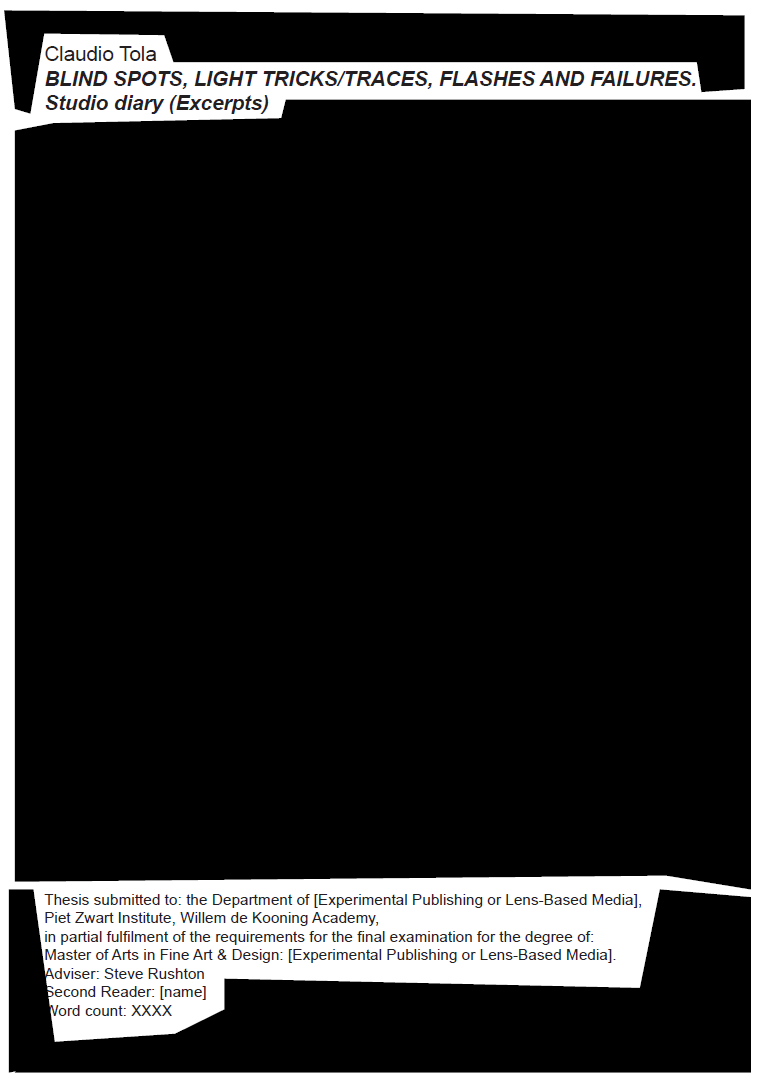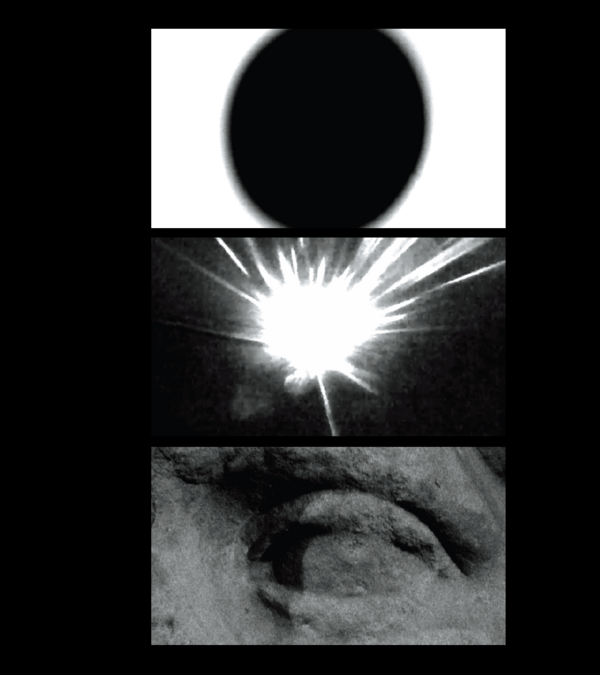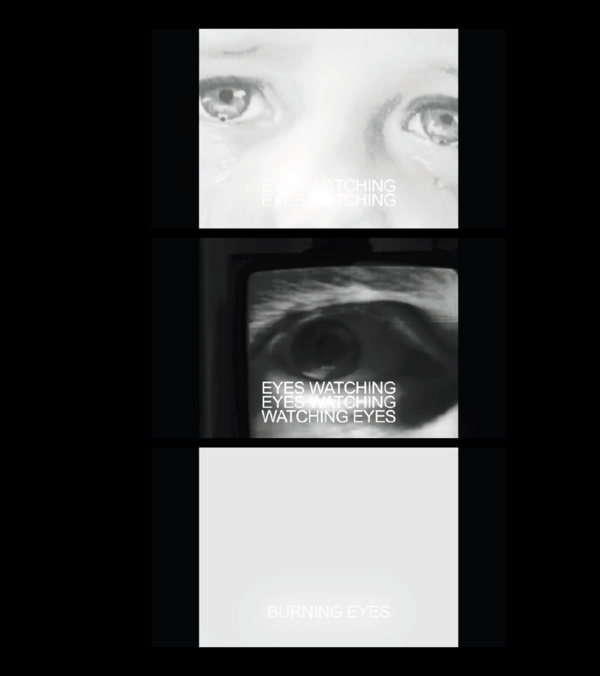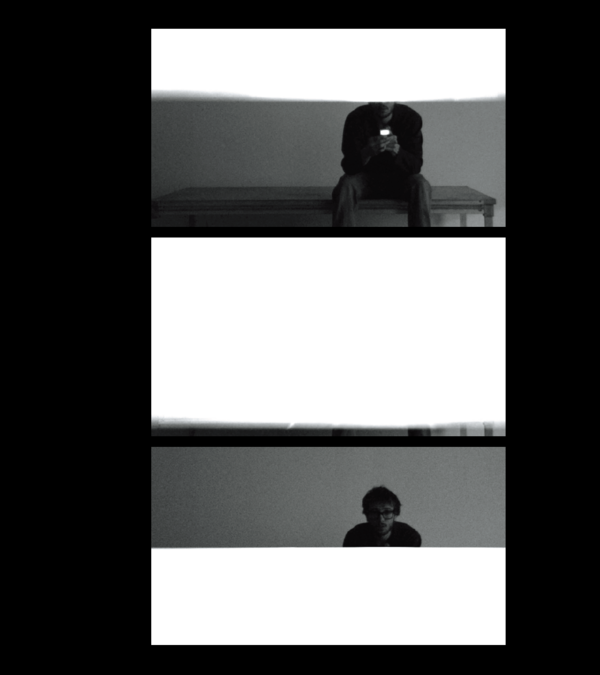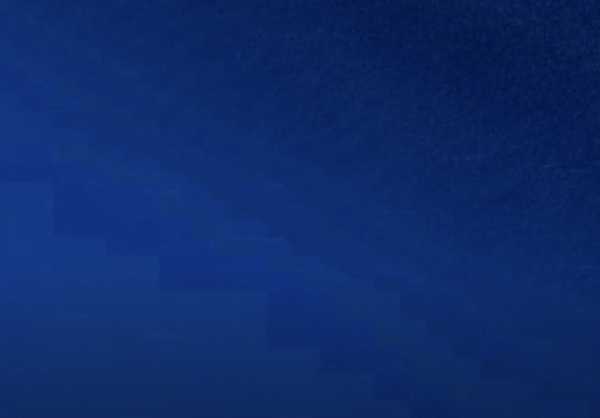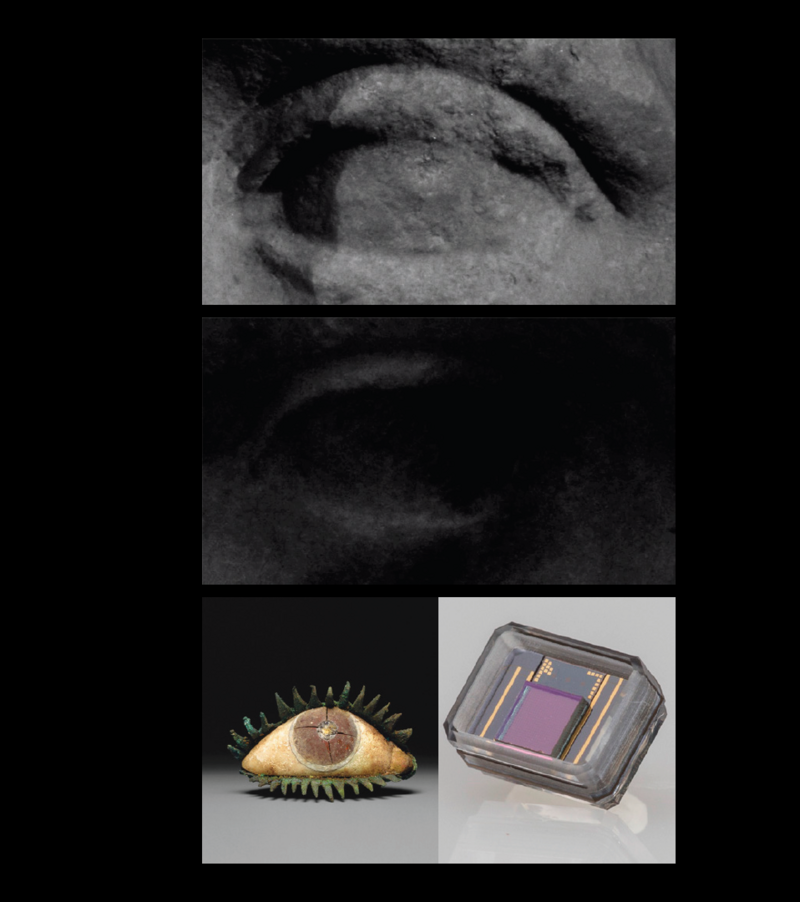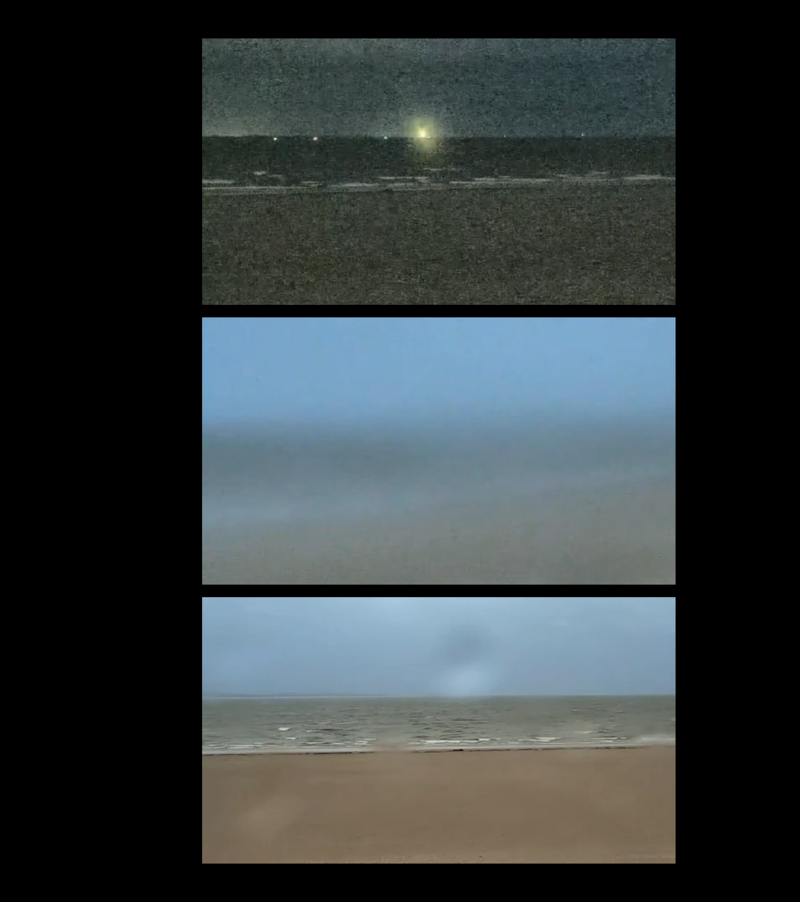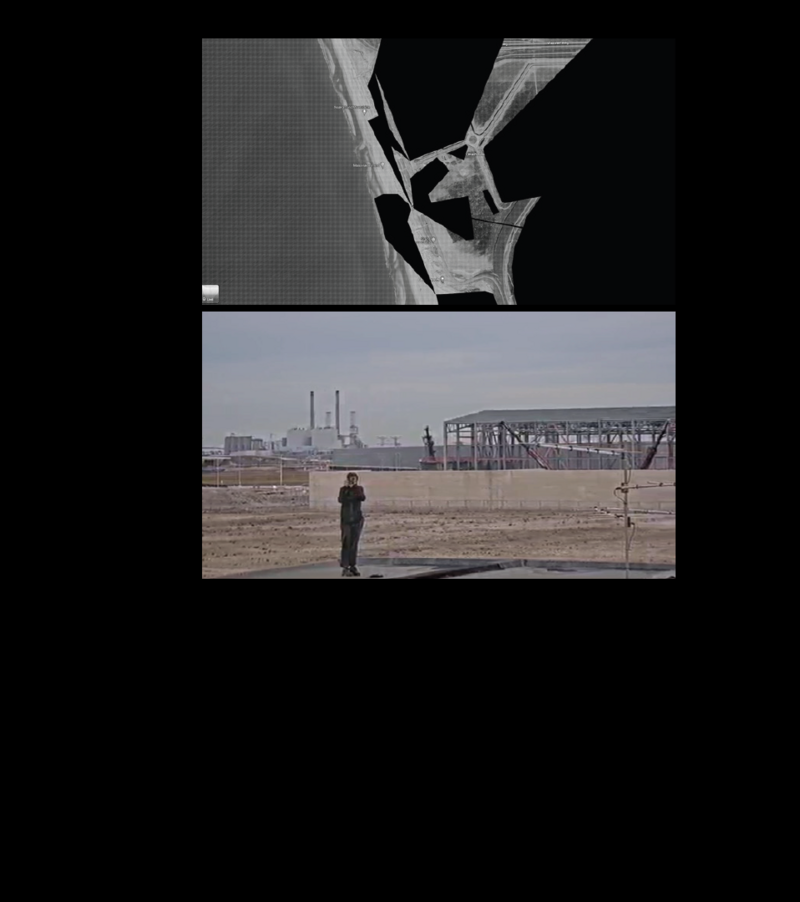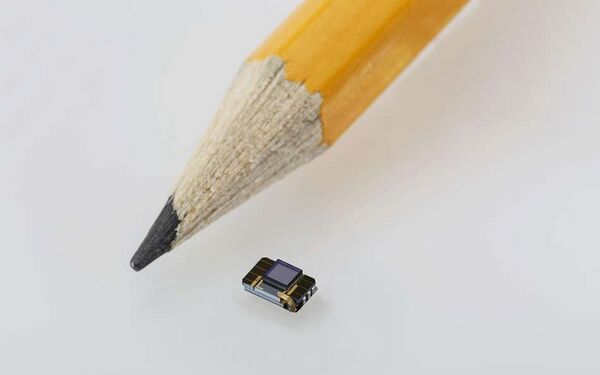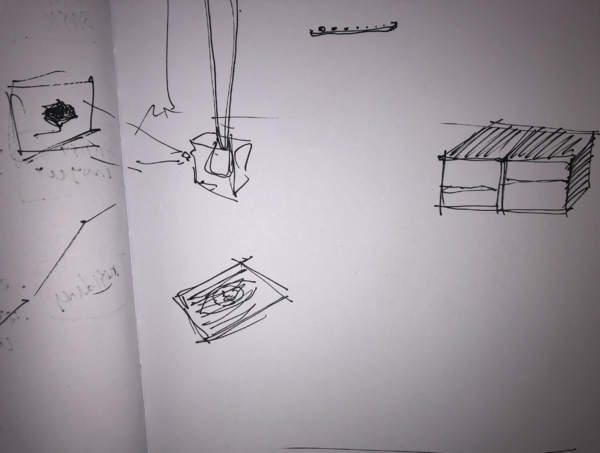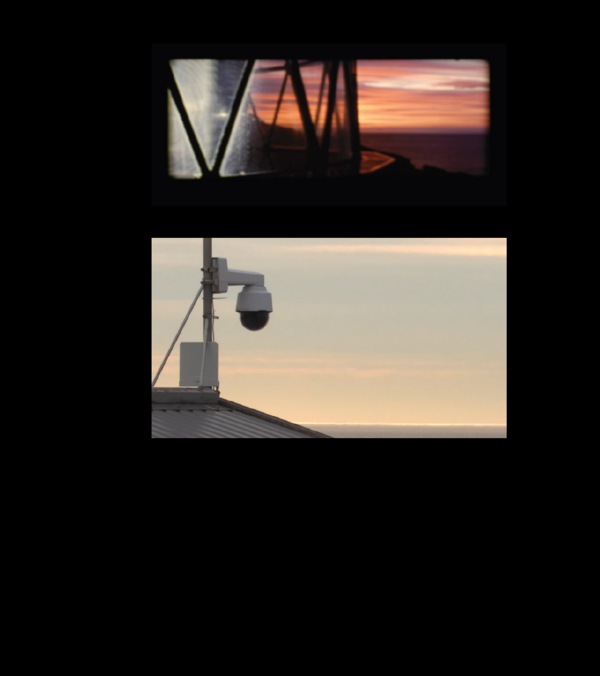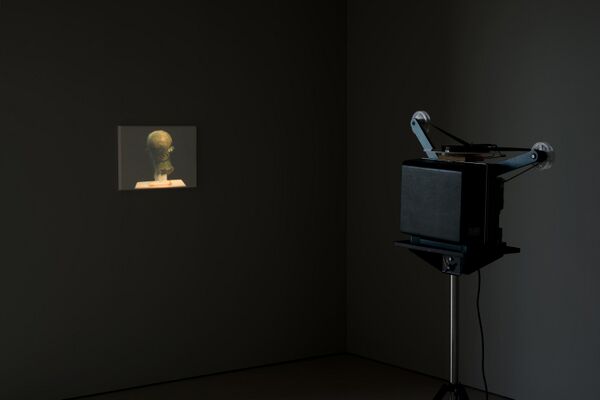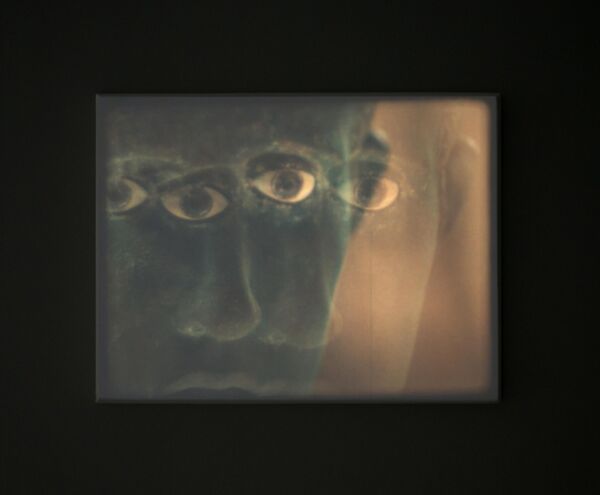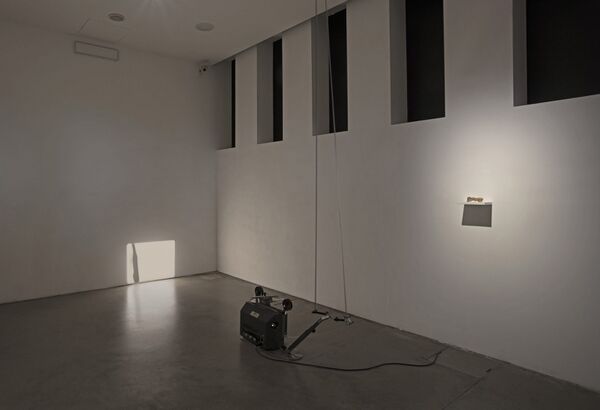Claudio's Thesis - SECOND EDIT
BLIND SPOTS, LIGHT TRICKS/TRACES, FLASHES AND FAILURES. A STUDIO DIARY. (EXCERPTS)
Foreword
This thesis is an attempt to track and annotate the unfolding of my work over the course of
the second year of the Lens-based Master program.
It is intended to be a complement to "making". A direct, on-going reflection on/of it. A
device to think through, to delve in, to dissect and clarify the reasons and stakes of the
practice I am establishing and the stances I am taking as a visual artist.
While editing this thesis, I decided to embrace some distinctive traits of
my writing, which seemed to recall some features recurring in my work: repetitions, pairs of
opposites, fragmented form, feedbacks. An intertwining between writing and making also
seems to appear in the use of such formal devices.
CHAPTER 1: (INTRO)
20-11-2023
This text is titled (INTRO).
(INTRO) is a general outline of the starting point of my graduation research project, BLIND SPOTS, LIGHT TRICKS/TRACES, FLASHES AND FAILURES. It will present its premises, the topics that the project will try to cross and address, the questions driving it, the tools I plan to use, the attitudes I will rely on.
(INTRO) is a self-analyisis of where I am at right now. Now that I have written a first Project Proposal and I am starting to grasp what I am dealing with yet I know much will change and evolve. Also, it will serve me as an exercise to devise an effective and convincing way to present and frame my intentions at the assessment in January.
During the first year I focused on a rather broad yet quite specific field of research, which I would frame as the theory and practice of image-making, and, conversely, of the experience of images, considered in their complex implications - technological/technical, material, semiotic, affective. In other words, I have been concerned with exploring the conditions of possibility of images by lingering on their limits. This project belongs to the same research path.
BLIND SPOTS, LIGHT TRICKS/TRACES, FLASHES AND FAILURES will be an elemental exploration of fundamental questions about seeing and being: the way we see, what we see, why we see, and where we stand in relation to this. It will question the experience of the world by seeing it, through and as light, on images and screens, their materiality - as physical/analog and virtual/digital objects, and the related quest to find meaning and stand in between these, living the tension between nihilism and the sublime. A personal reflection on the experience of seeing as well as a (self)reflection on the possibilities of the medium of (moving) images.
BLIND SPOTS, LIGHT TRICKS/TRACES, FLASHES AND FAILURES will take the form of a cumulative, open-ended, expansive work on visual material from different sources and with different qualities. Its subjects will be:
piercing light leaks and dark black holes, over- and under- exposed shots, webcam shots of empty beaches, blinding flashes and fast flickers, windows, curtains, screens, empty/lost eyes, pixels, digital noise, black and white blank frames [tbc...]
collected and choreographed together in short, stand-alone sketches/fragments. An annotation process will run parallel, unfolding meaning in written form, producing text material that will end up in this thesis work and in the final piece for the show.
BLIND SPOTS, LIGHT TRICKS/TRACES, FLASHES AND FAILURES will find its outcome at the graduation show as an experimental moving image work, in an installation form. I envision it either as a single-screen compilation or a multi-channel installation comprising of different speculative parts, mutually interconnected yet self sufficient. They will be exercises-of/attempts-at/challenges-to the act of seeing. For me while making, for the viewer watching.
Hereafter, I compile an expansive list of keywords that will somehow be called into question by BLIND SPOTS, LIGHT TRICKS/TRACES, FLASHES AND FAILURES:
(will MAKE THIS list into AN IMAGE/DIAGRAM NOT AS A TEXT, TO SAVE WORDS)
seeing/not seeing
showing/hiding
seeing/watching/staring/gazing
vision/blindness
visibility/invisibility
materiality/abstraction
edges/borders/thresholds/margins/limits/interfaces
errors-glitches-artifacts-failures
flashes, flickers
immateriality-materiality in/of (digital) images
blind spots
gaze/image/screen
physicality of images and image-making devices
depth/surface
lenses, sensors, screens, human eye structures
software/hardware, digital/analog, virtual/physical
technology/the technical
nihilism/sublime
I want to have a sculptural and open-ended approach. A DIY, “non-finito” approach of constant sketching. Making rapid, rough, short sketches, yet consistently, as a way to explore possible forms and meanings. To keep eyes open, to open eyes.
I want to work with images in a more dirty, reckless, less polished way. Not carelessly. But carefree. I am more interested in establishing a process and a practice rather than in making polished projects. Develop a practice against - or devoid of - the fear and the fetish of the final result. It is the way of working that I feel more at ease with and I believe it can be the most effective one in exploring and reaching the core topics and interests of my work. This does not mean I am not interested in reaching points in which I can show completed works to an audience. I see this ongoing practice as the source of a body of pieces whose meaning is made by their whole, and whose whole will be the foundation for the making of my final graduation piece. While I will still be using found footage, I want to be more behind the lens again, making and working with my own images too.
CHAPTER 2: STUDIO DIARY
21/11/2023 - An anecdote from last year. (1)
For the "Writing through editing" workshop last year, we were asked to make a short video piece using footage from an online Dutch archive. I made a piece titled A cameraman filming aka FILMINGWATCHINGBURNING. Digging in the archive, I found a rather intriguing clip from the archive showing two cameramen filming each other on top of a skyscraper being built in New York in the 1920s. Its self-reflexive nature immediately attracted me: its subject was not New York's vertical growth - which stayed, literally - in the background, yet the very act of filmmaking, of making images of the world, by means of cameras, on film. The subjects were the two filmmakers, filming each other while filming the world in front of them. I built my piece around that clip, editing it together with other footage - this time intentionally looked for, not found - to develop that self-reflective nature even further. A film projector, a film strip burning, as well as various shots of eyes. I intended to weave together the act of seeing/watching, the act of capturing the world through film, and a more intuitive notion of burning - light burns the chemicals on the celluloid, eyes burn when they stay open for too long, or, also, a burning desire and need to see things. Along the whole piece, with varying intensity, I layered a flickering effect, as a device to make the moving image apparatus sensible to the viewer, to recall the blinking of the eye, to trigger the physical perception of moving images and further play with the provoking idea and feeling of burning eyes.
In the first half of the piece, I crafted a sequence featuring a fast edit of footage of the two cameramen, images of eyes and text-on-screen playing with variations of the words EYES WATCHING / WATCHING EYES. All of a sudden, the screens goes black, abruptly. After a few seconds, a new text-on-screen appears, white letters on black: EYES BURNING. A hard flickering sequence - white and black frames only - follows, emphasizing even more the sensation of burning eyes. The same text stays on screen, floating through the flickering frames. Then, a blurry counter-shot image of a projector beaming light towards the camera appears - as if it was the source of that flickering sequence, and brings back the piece to figurative imagery. The piece then goes on.
When the screen goes black, the viewer's eyes - until then overstimulated by the mass of fast edited images - are caught unprepared. On that sudden pitch black, afterimages appear, the flickering effect seems to continue, and what is felt is the physical trace of the images seen before, their backlash on the viewer's retinas. Then, on that same black, the text appears. EYES BURNING. A subtle yet precise description not only of some of the images seen before - eyes looking at the camera, shedding tears - but also of the actual physical sensation built and triggered by those very images, the way they have been edited, the way they are felt by the viewer in that specific moment of the piece. A coincidence, a coming together of what is seen, perceived, meant.
The editing of that sequence was rather intentional, yet the witnessing of such effect was rather epiphanic, unexpected and striking. I feel this is an effective reference point in showing me a direction I want to pursue in my future practice, and that contains, in a nutshell, some elements whose use and potential I want to explore in making this new project. Abstract, minimal imagery, working with light as a raw material, self reflection on the medium, embodied/physical/haptic experience of images. Engaging and challenging the viewer's experience of moving images, their position in regards to them, both on a conceptual level and on a physical one. Making the viewer conscious of the experience of seeing, of being, challenging their perception, working on liminal, extreme states/conditions of images; blindness and sight, visibility and invisibility. These are all elements I am interested in addressing in my work.
05/12/23 - (WHAT) I'M INTERESTED IN (WHAT)
Through making BLIND SPOTS, LIGHT TRICKS/TRACES, FLASHES AND FAILURES, I’m interested in
exploring the fundamental elements and conditions of vision, its limits and the notion of blindness in relation to images and image-making.
light and its double potential to make things visible and to make blind. Its absence and presence, its double effects on images and vision. To drown in light, or to emerge from it. To appear and conceal. To make the world exist, or vanish.
the fine line between visibility and invisibility, between transparency and opacity.
those liminal moments when nothing (or everything) is seen as something, or when something that can't be seen becomes nothing. Things becoming nothing, something, everything in and through light, in and trough images.
exploring the liminal states between seeing something, everything, nothing.
the paradoxical link between nihilism and the sublime.
the tension between pure abstraction and mere materiality of images, between representation of the world and presentation of the medium, between seeing everything and not seeing anything.
images and screens as supports for such paradoxical coexistence of showing and hiding.
the concept of blind spot. Blind spots in ocular structures; blind(ing) elements in the "structure" of images (over/under exposures, out-of-focus, flickering ...); images and screens as blind objects; also, blind spots in perception of the world.
light as a flash. The flash of light as a concept, an image, and a physical phenomenon. The flash as the basic unit of light; as a (im)pulse for/on vision. As a singular, sudden event of extreme light that paradoxically reveals and blinds. As a device for apparition and concealment, of existence and negation. As a metaphor and image for both nihilism and the sublime. Also, the flash as the fundament of every experience of moving images, and of digital screens too.
the failure of images. The paradox of making fail-ed/-ing images as part of my image-making practice as a visual artist. I'm interested in exploring and working on events of failure of images. Failed images questioning their expected representative value. Images that represent nothing-ness, that show themselves as images, that are blind and that blind the viewer, both physically and conceptually.
I'm interested in the repetition and variation, in the redundancy, of images.
I'm interested in the durational experience/effect of watching.
28/02/2024 - An anecdote from last year. (2)
I spent a substantial part of my first year working on a research project centered on North Sentinel Island, a small island in the Indian Ocean whose inhabitants have refused contact with the outside world for centuries. The island is therefore mostly unknown, and the only knowledge about it comes from the very few images existing of it - the only possible ones, taken from far away, through telephoto lenses, from the sea or the sky. Although I gradually abandoned this project, I was - and still am, intrigued by this island that resists contemporary hyper-representation demands, and its compelling status of a place whose images are almost impossible to make - where image-making somehow is confronted with its limits.
In my research, which mainly consisted in trying to retrieve and reflect on all the existing images of the island, I often inspected the island on Google Earth Pro. While scanning the aerial imagery, I noticed a peculiar and unexpected detail that caught my attention, in that it seemed to strikingly and precisely address the core meaning of what I was trying to do.
I observed that Google Earth had mapped/pictured the ocean surrounding the island only up to a certain radius. I observed that all around the island, at a quite regular distance from its shore, the photographic imagery ended and the surrounding ocean was left in a blank, solid blue color, as a generic placeholder for an oceanic area that has not been rendered photographically. The "interest" of Google is focused on the island, limited to it, while the rest is left unmapped, not worth of a mimetic representation, not worth of photographic realism.
What was even more intriguing was what I observed at the border between these two modes of representation - realistic/photographic and symbolic/iconic: a threshold, a circular edge, a pixelated gradient, a strip of clustered pixels, jerkingly transitioning from the ocean's photographic images to the solid, flat blue standing for a symbolic reprsentation of the ocean.
A similar artifact allegedly appears around every similar island - sufficiently isolated in the sea. However, this visual phenomena seemed to acquire a particular, unique, relevant meaning in relation to the specific case of North Sentinel Island - its inhabitants' struggle to be left alone, their refusal towards the outside world, the inaccessibility of the island both for people and for cameras. What seems to be at stake in that pixelated edge is the clash between an effort, an attempt, a desire to see, know, grasp, control and an active resistance to that, its refusal, that poses that desire in front of its own limit, that makes it fail. Also, a reflection on the constructed nature of images - digital, photographic, scientific, but all images in the end: their supposedly realistic nature against their abstract, opaque materiality - pixels encased in a grid on a screen.
Instead of scanning the island from above, as I was planning to do before, I resolved to only make footage scanning this line, orbiting all around the island without showing it, yet suggesting that there’s something in the middle, which is left out, unknown, unseen, while focusing on the threshold between representing and not representing it, on the very act and moment - whose that pixelated edge is a trace - of the making of an image and its layered implications.
This discovery was eye-opening in terms of understanding the reasons and core concerns of the research I was making. It made the island and the attempt at making images of it catalysts to speculate about bigger topics that the island alone couldn’t answer but only hint at. It made me slowly realize that the point of that research was image-making in its essence - a certain human attraction to see the unknown, making sense of the world by making images of it. A matter of mankind, of image-making, of image-making mankind, of mankind making.
11-12/01/2024 - PROJECT PROPOSAL v.2
Towards January assessment, I wrote a new version of my proposal, which renders the way my plans have progressed in the past one and half months, I was being told that I was only playing around with formal aspects, without considering - or even worse, withdrawing from doing so - the agency that my images could have in the "wider" world. I was also told that it was very hard to engage with what I was making, because of its extremely self-referential, abstract natrure which could hardly offer any grip on reality for an audience to access it.
My plans seem to have taken a more tangible form, that of a proper project. It will surely evolve and change, yet I feel that, finally, I have something solid to stand on. I feel as if - suddenly - I could link elements and thoughts that were already there - yet scattered - in a more stable and meaningful constellation. There's a series of elements, and a clear, sensible idea of the way I want them to be made and to stand in relation to each other.
I am "constantly chiseling my own works and words". I feel that this relation between writing and making is working out fruitfully, allowing me to focus on and bring out my own reasons to make this project, and therefore to develop it steadily and substantially.
Hereafter, I compile some relevant excerpts from that text, to present this new iteration of my project.
(note: to respect the word limit I retroactively decided to only keep the parts of the project proposal that I kept working on, discarding the rest.)
As of now, BLIND SPOTS, LIGHT TRICKS/TRACES, FLASHES AND FAILURES will consist of four sketches (or: scenes), to be presented as self-standing video loops on four different screens.
Their (working) titles are:
1) SENSORS
2) W-O/A-NDERCAMS
3) L S T O L T O S L O S T T O S L
4) Untitled, or: SCREENSHOTS
Together, these sketches (or: scenes) explore and articulate in various ways and from different angles the field of research that I outlined above.
All four are, at their core, exercises in/attempts at/challenges to the act of seeing and of making images. They are so both for the audience - experiencing them in an exhibition setting - as well as for myself - while engaging in their making.
They are in fact outcomes of an experimental - literally, made of trials and errors and feedbacks - approach to moving image-making. Results of extensive acts of watching and filming, challenging the technical limit of the devices - of capturing images, of showing them.
They all move on and question the fine, blurred line between human desire/need to see and to make sense of the world by seeing and making images of it, and the impossibility of such an attempt, when seeing and image-making happen to fail.
They address the experience of the world by seeing it, through light, on images and screens, the materiality of such devices and the related quest to find meaning and stand in between the world and its techonology-mediated representations.
They shape a speculative reflection - personal and analytical, structural and poetic - on the experience of seeing as well as a (self)reflection on the possibilities and limits of (moving) images.
They stem from - and thus require - a contemplative and speculative attitude.
I will now provide a draft outline of each of the four sketches that make up BLIND SPOTS, LIGHT TRICKS/TRACES, FLASHES AND FAILURES.
[...]
1) SENSORS (8-10 minutes)It will consist of closeup shots of empty/blank/lost eyes of classic greek sculptures, filmed either in the Greek section of the Louvre Museum in Paris or at the exhibition on classical greek sculptor Phidias that is currently being held in Rome. I intend to shoot these images on analog film; either on a high contrast, black and white 16mm stock, or as still pictures on 35mm photographic film. Images of these statues and their eyes will be slowed down and will appear on screen as shapes that are continuously, gradually lost and found. They will be seen and then lost and then seen and over again. The viewers will find themselves actively looking for something to appear, and what they will see are eyes - or traces of now lost, blinded eyes - looking at you. When you see it, you are seen too. The eyes’ shots are spaced out by blank frames of various length. These images are accompanied by a text - ideally in the form of a voiceover - that will draw a speculative parallel between:
- how eyes were crafted in classical greek sculptures and how they decayed and they are now lost, their symbolic/cultural value and the link between such representation of the eyes and contemporary philosophical theories of vision (very physical/material - images as objects colliding with eyes, eyes shooting rays towards the world)
and
- the current, failing state of technologies for bionic eyes - experimental implants of nano-sensors in retinas to partially recover vision of blind people (the eye becomes a digital camera)
I am interested in articulating this analogy between these small high-tech objects, made of precious materials, speaking of a persistent human quest, a need, an obsession for the eye/vision/seeing over time. Both are reflections of contemporary cultural constructs around vision. Both are on the edge between a material loss of vision and the creation of a sense of it - of seeing, of being seen. The whole sketch revolves around a quest for seeing, for "making" eyes, while the viewer is drawn to look for and “make” the eyes on screen, actively engaging their own vision.
2) W-O/A-NDERCAMS (12/24 minutes)
This sketch will be a compilation of footage from 2 webcams set up on dutch beaches for safety and weather reporting reasons and available as 24/7 live-streams online. These webcams perform automatic movements, according to internal algorithms; they continuously scan the beach, the sea, the horizon, zooming in and out, and the feeling they provide is that of a constant quest to see something, a quest that is always bound to fail. They seem to be seeing everything out there, yet what do they see? What are they looking for? Lost eyes, stranded, blind.
Every day, at sunrise, over the course of an hour, the image they provide transitions from a digitally-grained, black and white, opaque, “blind” image, to a well-exposed image - yet always artifacted - of the beach they are on. The same, in reverse, happens at sunset. From seeing almost nothing, to seeing something, then everything in full sunlight, and back.
The subjects that this sketch deals with are multiple and interconnected.
The webcams’ contemplative, absurd quest across the sublime, yet eerie landscapes they show. What are these wandering cameras, lost eyes, looking for, what are they absurdly aiming at?
Staring at the sea/horizon/sky as a primordially human act of seeing and of being the world; the sea and the horizon as “screens”, whose staring at has to do with appearing signs, passing time, understanding someone's own position in the world.
The cyclic construction and destruction of the image, the staged process of its material making and unmaking, by means of natural sunlight, through a camera sensor, on a screen.
A state of hyper-presence of machinic, technical gazes and of over-production of images, that are continuously made, unnoticedly.
I am also interested in questioning the position of the viewer - myself in the first place - in relation to these webcam's images. Not only, then, what are these wandering cameras looking for? But also: what am I - what are you - staring at the images made by those cameras - looking for? I am therefore considering the possibility to embark on a journey to go find and see these webcams, and the places they depict, in real life, in first person. Again, an absurd quest to see, and to see what? To cross, to challenge the threshold between the world and its representation, to physically engage with the materiality of such immaterial processes of image-making and mediation of reality.
3) L S T O L T O S L O S T T O S L [...]
4) Untitled, or: SCREENSHOTS [...]
07-02-24 - ONGOING TRANSFORMATIONS/DEVELOPMENTS (1)
I resolved to temporarily carry on only Part 1 - SENSORS and Part 2 - W-O/A-NDER-CAMS of my Project Proposal - the Greek statues' "lost" eyes piece and the "stranded beach webcam" one - as I feel those are the ones that offer more space for development.
I now see Part 1 - SENSORS as a short (2/3 minutes) 16mm loop projection featuring images of those statues' eyes, filmed in black and white 16mm film stock at the Louvre museum and then edited at Filmwerkplaats - which I am now a member of. I will probably make use of so-called optical printing - an analogue technique of re-filming footage frame-by-frame, allowing to alter and affect it with effects such as slow motion, re-framing/cropping, focus/unfocus, over/under exposure. I am also considering to integrate in the edit - as elements fragmenting and layering the images of the eyes' statues - some added material interventions on the film surface that further contribute to the reflection on vision, blindness, physicality of images that my work is concerned with. The piece will be installed as a16mm projector running on a loop. I am planning to film the statues either in the Louvre in Paris or, better yet more challenging, in the National Museum in Athens, Greece.
Concerning Part 2 - W-O/A-NDER-CAMS, my current plans are considerably different from the ones outlined in the proposal. I have decided to work with footage from another webcam. The premises are still the same - real-time, automated scanning of a beach in south Holland live-streamed online - yet this new webcam has some features that makes it more interesting for my purposes. For example, it performs a full 360 degree turn (and not just 180), scanning not only the seafront but also what is behind - an eerie, deserted industrial landscape. Also, the focus of how i intend to work with such webcam has shifted. As I have started visiting these places where these webcams are located, I realized that what is at stake is related to notions of real-time-ness, of actually being in those places, and wandering through them, and engaging bodily with them; with the experience of them as opposed to the screened experience from the webcam. Notions of and tensions between presence and absence, showing and hiding, being there but not being seen, seeing without being there. Staging acts of looking at, of looking for, of being looked at. I am therefore working on the intention of pairing the footage from the webcam with "stolen" countershots that I take while crossing the landscape, trying to move in - or, to be - the blind spots of the webcam. A counter-act of image-making, where the scanning of the place is the one of my own body/eyes/camera crossing the landscape, revolving around the webcam, engaging with its field of vision and its limits. I am considering the possibility - and the implications - of letting myself, my own figure, be caught in between these two cameras, these two gazes.
I feel these two parts - in all their differences - are nonetheless somehow alike. In both cases, a tension towards an object that holds - or used to hold - a gaze is displayed; a quest to go and see back these "seeing objects", to make body and eye contact with these. An intentional attempt at confronting that gaze, at establishing a relation with it, at questioning the reciprocal position in such interplay of seeing and being seen. I find it interesting that, after spending most of my time staring at a screen in the LB studios - which I consider anyway a fruitful experience, I am eventually heading out to such places - both fairly remote, be it Paris, Athens or the deserted landscape of the webcam - physically engaging with them, with a camera in my hands. Further reflections on this will come (EXPAND?).
25-02-24 - ONGOING TRANSFORMATIONS/DEVELOPMENTS (2)
I am tinkering with two new possibilities, along the first two main pieces that I described in the previous paragraph.
- bringing in the essayistic, text-centered part- consisting of research notes, speculations that I am currently producing on the side - as a standalone element in the final grad installation. I envision it as a fragmented moving text on a screen, unfolding through a scrolling movement, both vertically and horizontally. I asked my dad to film his eye from upclose, in front of a mirror, with his smartphone, staring at the camera. I did the same. This footage will be on the background of the text; our eyes will alternate, along with our words and reflections.
- in relation to the statues' lost eyes, and to the reflections on my personal possibility of going blind, bring in as a 3D-printed object the image of one of the most advanced sensors for retinal implant that I have come across in my research (NanoRetina NR600). Based on the only two images I have found of it, I intend to make a 3d model of it and print it. As it is a very small object, I have been suggested by the assistant at the 3D Printing station to first try printing it bigger and then progressively smaller until the "resolution" of the printer is able to render its shape and details. I find this very interesting, and I might want to show the whole series of prints - from a relatively big and detailed one to a tiny chunk of molded plastic. Again, a process of degradation of an eye, of losing resolution - but, paradoxically, the more it loses detail, the more it gets to the actual dimensions of the object, those that allow it to actually work.
I still - and maybe even more now - envision this project to take the form of a constellation of several - relatively - small, simple pieces, different in forms and media, yet addressing, and outlining, from different angles the research field that I have been progressively acknowledging as the core of my practice as an artist.
30-03-24 - ONGOING TRANSFORMATIONS/DEVELOPMENTS (3) (after stefanos seminar)
......... latest stage of grad project plans. a bare description of the 4 elements.
DO I still have WORDS FOR THIS?
CHAPTER 3: CASE STUDIES (THINKING ABOUT MY WORK THROUGH ANNOTATING OTHERS')
18-01-2023 - Notes on and from Tacita Dean's Disappearance at Sea (1996)
I came across Disappearance at Sea researching about Tacita Dean's work as a contemporary artist working with 16mm film, referring to a heritage of structural cinema tradition yet making work that is not only self-reflexive but also narrative and speculative. All elements that seem to resonate with my practice and that were also remarked during the assessment as something whose place in my work I need to consider. On top of this, this film seems a relevant example to reflect on in relation to the piece I want to make with the footage from the webcam scanning the beach at sunrise and at sunset that I presented in my proposal. (Part 2 W-O/A-NDERCAMS)
Tacita Dean's film is 14 minutes long. It is a sequence of scenes shot in and from a lighthouse, on the British coast, at sunset. Abstract close-ups of the lighthouse revolving lamp, and four different views of the seascape/horizon (two of them partially framed by the lighthouse architecture, two only consisting of the landscape view). As the sun sets, the shots get darker, the light emitted by the lamp becomes more visible, and is seen projected on the landscape. The end is a pitch black screen. The seven shots are approximately 2 minutes long each. It is shown as a 16mm projected loop.
Comparing Tacita Dean's work to the way I want to go about my piece seems to bring together some thematic and structural similarities as well as some differences.
1) I feel both works imply a reflection on human-made technologies to see and, through seeing, to grasp the world, to know it, to hold it. Tacita Dean's work speaks of such a human strive to see everything and, through seeing, to grasp the world, to control it, yet I feel the lighthouse - as a rather ouTacita Deanated device of seeing - places her reflection on a rather poetic, literary realm, rather than the sociopolitical one that appropriating a webcam's footage can imply. Also in Tacita Dean's work, the material features of the 16mm film apparatus - light shining through film - are more directly referring and mirroring with the natural sunlight that is present in the film.
The fact that I am appropriating fotage from a 24/7 live-stream online webcam calls into question the ubiquitous presence of visibility devices - cameras and screens - a "regime" of visibility, of mass production - and consumption - of images, to which we are constantly subject to, and object of. I feel this comes across through the inherent, material qualities of the footage I am using - the camera movements, the lo-fi digital texture of the image. I feel I need to address it more directly in the way I engage with such footage and the webcam's own presence, as a physical object in a physical place.
I believe that my interest in blindness - or the failure of the act of seeing and making images - has to do with this, as an interest towards a possible way out, an escape from such a state of hyper-visibility and hyper-exposure to images.
On a more "formal" level, in my footage, the point of view is that of the webcam; the viewer coincides with the camera, their gazes coincide. In Tacita Dean's film the point of view of the camera is external, a third party. This creates a triangle play between the landscape, the lighthouse, the camera/spectator, a triangle that is staged through a shot-countershot structure. I don't have that. What does that add? Can I try to do a countershot of that particular webcam I am using? Is this what I should aim for when going and find the webcam? Maybe.
2) Both Tacita Dean's work and the one I intend to make strongly call into question the notion and the experience of time, both in similar and different ways. Tacita Dean's work addresses time as a cycle, as a perpetual repetition, rotation, again on a rather philosophical/phenomenological and poetic level. The perfect rotation of the lighthouse lamp is a strong metaphor for this.
The same happens with the footage of my webcams, which also stage a cyclic structure of passing time. Yet, as they stream live, 24/7, they also confront the viewer with the continuity in time of the production of this imagery, with the specific nature of this digital gaze which is always on, as well as with the possibility/limits of a mediated, real-time experience of a place. The footage produced by the webcam can be retroactively watched for a limited period of 12 hours, after which it is permanently lost. A matter of disappearance here too, not only of a place into the darkness of the night, but of its volatile images floating on the internet.
3) In both works, the only human body that is at stake seems to be the one of the viewer, whose experience and position seems to be included as an inherent element in the piece through the durational, prolonged watching act that the work requires. No other living bodies are in sight in Tacita Dean's film. What if - in my work - I appear in the webcam's visual field? That's another body. My own, but also a projection for the viewer. What would that mean, to place myself in that imagery? To let my own figure in it, caught by that gaze? What new relationships with the camera's point of view would be established? What tensions would become visible? What would that presence speak of in terms of contemporary states of image production and visibility? 4) Both pieces confront the viewer with a contemplation of a deserted seascape and its horizon. Despite the different qualities and textures of their images, they appear to me as allegedly universal objects of human gaze, as catalysts for a tension, for a quest for something that is expressed through its staring at.
27-02-2024 - Notes on Runa Islam's Meroë (2012) and Peng Zuqiang's Déjà vu
These are some observations on two works that I recently came across as potentially relevant references for the piece that I intend to make with the 16mm footage of the Greek statues (titled SENSORS in the project proposal)
The first one is the film Meroë by artist Runa Islam.
Excerpt from an exhibition text:
Using the technique of double exposure, Islam carefully overlays images of an antique bronze head of a Roman emperor with a replica plaster cast produced by the British Museum after its acquisition. The two versions – the ‘original’ and its ‘duplicate’ – merge and diverge. Short sequences show the head from all angles; the back, the front, the sides. Whilst the two heads remain in different collections in different locations, each film frame becomes a new site in which the distances between original and copy are diffused, and the casting process is reversed.
This work - which, I have to state, I have only known through still images from exhibitions - seems to feature both similarities and differences with what I intend to make, and therefore feels like a useful one to reflect on.
- The subject is somehow similar: a scanning observation of a bust from ancient times - and its modern copy - on 16mm film, presented as a loop. 16mm's inherent material qualities activate a reflection about - and between - reality and its depictions, the world and its representations, the shift between original and its copies.
- Islam's film is built as a series of carefully crafted double exposure shots, precisely and meticulously composed. Everything is under control. The materiality of the film is there and, of course, yet it doesn't seem to be excessively exploited/used/ - no marks, traces, artefacts on its surface. Islam's images are clean and crisp.
- Islam's focus is on the full face of the two statues. She is interested in them as full object(s) - which are clearly presented as a remnants of a bigger body.
My film will be showing a series of closeups of eyes from a wider selection of statues. So, not one specific object filmed from different angles, extensively, but an extensive compilation of similar objects, filmed in a recursive manner.
Yet, my subject choice will be as specific as the one made by Islam for her film, as all the statues will be specifically belonging to the Classical Greek period (V-VI century BC), and chosen in relation to the specific way their - now lost - eyes were crafted in those times. I am planning to go find such statues either in the Greek section of the Louvre museum in Paris or in the National Museum of Athens.
I want to film them from up close, as abstracted forms of holes, scars, scratches, marks, that one recognizes as eye-like shapes. These shapes emerge as traces, marks on the face of these statues, and will be rendered and seen as light traces on/through the surface of the film. I am interested specifically in the value of those traces, in their being remnant of once realistic depictions of eyes. I am interested in echoing this through the film material, as well as activating a process of looking at these shapes to look for the eyes, and of feeling looked at reversely in the meantime. I am no interested in showing the full facial features or bodies of these statues, which would be misleading for the purpose of my work..
Eyes are looking back at the viewer in Islam's work too. An interplay of gazes is going on in her work too for sure, yet it seems to be a side element in her work, while in mine, it will be the main thing at stake. An interesting element in the display of Islam's work is that the film is not projected on a plain wall, but on a custom-made plaster screen/surface, whose material matches with the copy version of the statue present in the work, seemingly building a parallel between that copy and the same status of copy of the imagery of the film - and of all representations. This reminds me of considering the surface of the projection, its physical qualities as inherent element to the piece. I was thinking of having a a slightly reflective surface as a screen, that would let the projector's light source appear as a slight reflection somewhere in the center of the screen, interfering - and somehow "blinding" - the projected images of the eyes.
The second work that I would like to consider is Dejà Vu by artist Peng Zuqiang, which I have recently seen installed in an exhibition in Torino, Italy.
Again, an excerpt from a description of the work:
A 16mm film projection unveils an abstract, flickering black and white image of a vertical line in constant movement. For this work, the artist exposed 30 meters of metal wire directly onto 30 meters of film negative. The line that emerges is the trace left by the object on the celluloid material. The metal wire, here, may be read in all its ambivalence, as a device for entrapment, as a tool of escape from high rise building, or of erotic pleasure even.
The work is completed by a soundtrack, a first-person narrative through his own and others' memories of bodily injuries in the public and private sphere.
The line in Déjà vu becomes an ontology for the thin membrane, characterized by afflictive transfers and the perpetual inscribing and exposure of memories, emotions, and sensations—analogous to the presence of the film itself and the pervasive sonic and mechanical clatter of the 16mm film projector.
A 3D-printed clay replica of a precious Qing dynasty calligraphy brush rest on the window seat in the exhibition space. Originally made of jade-like opaque glass and to be found in the households of royals, artists, or poets (usually men), the brush rest is molded in the shape of a kneeling naked boy leaning forward on the floor and translates into an object of status (and perhaps homoerotic desire). Just like the imprint of a wire left on the celluloid of the film, the visceral cracks and wounds on the artist’s copy’s head and body testify to a longstanding history of violence and objectification of vulnerable subjects.
I am mostly interested in this work for the strategies used in its installation form rather than its thematic content, which is rather distant from the field I am moving on.
- The way the film loop is displayed - vertically hanging from the ceiling, right above the projector which is placed on the floor - is possibly one of the simplest to set up, but also intriguing for me as it "presents" the almost full length of the film, which is visible as an object in the space (other film loop systems are way less explicit in presenting the film material). More than that, I am interested in the vertical scrolling movement of the film - enhanced by such setup - which I imagine would resonate by contrast with the predominant horizontality of the scanning movements in the webcam piece, further articulating their relation beyond the digital vs analog comparison.
- The installation is completed by two other elements: a sound piece, with a narrating voice, and a small 3d-printed sculpture on a small shelf. They both add further layers of meaning to the relatively bare and simple film projection, opening cross references and relations of scales, dimensions, temporalities that the film projection alone would not have. This is a very similar strategy to what I am thinking for the grad show. A constellation of relatively simple, standalone elements, each with their own agency and yet parts of one single body of work and research that investigates the same questions. I am also working on a text-based element - which will probably become a scrolling animation on a small screen - as a device to bring in a personal narrative that further enriches the rest of the project, as well as a small sculptural element - a 3d printed/laser-cut copy of a prototype for a bionic eye sensor based on the only image available of it online, which would somehow mirror the "lost" eyes of the statues shown in the film, and further articulate the discourse about human relation to seeing.
CHAPTER 4: (OUTRO)
I initially intended this project to be an open ended process of exploring some core concepts and topics that the title - BLIND SPOTS, LIGHT TRICKS/TRACES, FLASHES AND FAILURES - was supposed to outline. Over the following months, it unfolded in rather unexpected directions. I started with sitting in front of my camera, in a room at school, the curtains closed, blinding it with a flashlight. I ended up filming on a deserted beach at sunrise, in the middle of the winter. As paradoxically distant as they might seem, I feel they are different moments, iterations of a rather linear, coherent research.
I started with a radically reductionist approach: extremely abstract, structural imagery - black and white, without sound nor narration - conceived and presented as a loose compilation of short fragments. I had reasons for making such work, yet I could hardly make them explicit to others. While I have kept my minimalist approach and my concerns regarding the material nature of images, I gradually found ways to open my work up, letting go of self-imposed restrictions and making my way out of that self-reflective rabbit hole of visual trickery (as David would often say) that an audience could hardly engage with.
I feel this has happened because of being repeatedly encouraged to reflect on and embrace a relation to a wider context, not only of artistic references, but also and more importantly in terms of implications with the "real world". I often found these feedbacks frustrating - I have to admit, but I now recognize their value.
One of the goals I had for this year was to establish a personal way of working, a practice. I feel I took relevant steps in this direction.
Another turning point - relatively recent, as it came out of Stefanos' studio visit - was the acknowledgement that in my practice is the processual/procedural part is key. That is what makes the visual outcome - as eye-catching as it may be - valuable for an audience to engage with, and it should therefore be presented as an integral part of the work, of the sense it makes, of the reflections on the world it aims to present. I realised I was instead leaving it out, trying to hide it.
I feel I have always worked on the same trajectory - with the same elements, and around the same topics. Cameras, my own body, eyes, the act of looking or being looked at, of seeing and of losing sight, of making and experiencing images. What changed is the degree of contamination with the wider world that I have gradually allowed into my practice.
I started mixing found imagery with footage I filmed myself, started spending more time - working, living - outside of the studio, brought in autobiographical reflections - all things that I was somehow banning as not relevant, or as distractions, which on the contrary turned out to be key to effectively address the core interests of my practice, which I was somehow failing in doing with that structural approach alone.
I developed a recursive interplay of looking at and reflecting on found images, places, circumstances - very specifically chosen yet treated as case studies for larger states of things- from afar or from up close, mediated through a screen and in-person, merging a contemplative attitude with a speculative take, using editing and writing as mutually feeding practices.
I learnt be more flexible, less strict with my work, with myself too. I learnt to accept the chance, the casual encounter, as parts of the process, that can potentially overturn it in unexpected, surprising ways. I learnt to let more life in.
REFERENCES
Disclaimer: The following list is compiled as a loose constellation of theoretical references - mainly in the form of written texts, video interviews, artworks, films - as an attempt to build and articulate the background of words, ideas, imagery that my work is somehow related to. I claim an unruly approach to theory, whatever it may be: hand-picking bits and pieces from different sources where I come across resonances with my own intentions and interests, without the overwhelming weight of having to fully master and know the whole of it.
BIBLIOGRAPHY
SCIENTIFIC/ACADEMIC RESEARCH ABOUT STATUES / BIONIC SENSORS / VISION / BLINDNESS
Witcombe, C., 2018, Eye and Art in Ancient Greece: Studies in Archaeoaesthetics, Turnhout: Brepols Publishers.
https://www.abebooks.com/9781909400030/Eye-Art-Ancient-Greece-Studies-1909400033/plp
Stager, J. M.S., 2022, Seeing Color in Classical Art.Theory, Practice, and Reception, from Antiquity to the Present, Cambridge: Cambridge University Press.
https://cloudflare-ipfs.com/ipfs/bafykbzacebyag7ya4eg7isaoap63nmprzsozh7ha5yosohl2npnsmvg6pry2q?filename=Jennifer%20M.%20S.%20Stager%20-%20Seeing%20Color%20in%20Classical%20Art_%20Theory%2C%20Practice%2C%20and%20Reception%2C%20from%20Antiquity%20to%20the%20Present-Cambridge%20University%20Press%20%282023%29.pdf
Squire, M., 2016, Sight and the Ancient Senses, Oxford: Routledge.
https://www.routledge.com/Sight-and-the-Ancient-Senses/Squire/p/book/9781844658664
Frontisi-Ducroux, F. 2001 (1975). "Living statues" in Antiquities (Postwar French Thought Volume III).
N. Loraux et. al. eds. New York: The New Press, 164-175.
Frontisi-Ducroux, Francoise; 2001 (1975). "Living statues" in Loraux, N. et al., XXXX, Antiquities (Postwar French Thought Volume III), New York: The New Press, 164-175.
Brinkmann, V. and Wünsche R., 2007, Gods in Color: Painted Sculpture in Classical Antiquity. Munich: Stiftung Archäologie, 2007.
Grossman, J. B., 2003, Looking at Greek and Roman Sculpture in Stone. Los Angeles: Getty Museum.
Nano Retina, 2024, Nano Retina's Eye Implant Technology [online] Available at: <
https://www.nano-retina.com/technology/#3dni> [Accessed 05 March 2024]
Schott, xxxx, Meet Nano Retina: Giving the gift of sight [online] Available at: <https://www.schott.com/en-nl/about-us/references/nano-retina> [Accessed 05 March 2024]
AAVV, 2019, An update on retinal prostheses, [online] Available at: <https://www.ncbi.nlm.nih.gov/pmc/articles/PMC7198351/> [Accessed 05 March 2024]
Harris, M. and Strickland E., 2022, Their bionic eyes are now obsolete and unsupported [online] Available at. <https://spectrum.ieee.org/bionic-eye-obsolete> [Accessed 05 March 2024]
Bionic Eyes, 2024. Database of bionic vision devices. [online] Avalable at: <https://www.bionic-vision.org/devices#> [Accessed 05 March 2024]
Burns, J. (2023), Oregon scientists are building a better bionic eye, [online] Available at:
<https://www.opb.org/article/2023/09/13/university-oregon-scientists-bionic-eye-retinal-implant-technology/> [Accessed 05 March 2024]
TV report- Nano Retina presentation on the Italian Rai channel
https://www.youtube.com/watch?v=sWnfX3HcLeQ
-------------------
EXPERIMENTAL FILM / STRUCTURAL FILM READLIST
AA.VV., Film as Film: Formal Experiment in Film, 1910-1975, 1979.
Available at; https://monoskop.org/images/3/36/Film_as_Film_Formal_Experiment_in_Film_1910-1975.pdf [accessed 05 March 2024]
Smith, W.S., (2009) A concrete experience of nothing. Paul Sharits’s flicker films, in RES Anthropology and Aesthetics n° 55/56, p. 279-293, Chicago, 2009.
Available at: https://www.ubu.com/papers/Sharits-Flicker- Films.pdf [accessed 05 March 2024]
Gidal, P., (1976), Structural Film Anthology, London: British Film Institute.
Available at:
https://monoskop.org/images/6/65/Gidal_Peter_ed_Structural_Film_Anthology.pdf [accessed 05 March 2024]
Wees, W. C., 1992, Light moving in time. Studies in the Visual Aesthetics of Avant-Garde Film, Berkeley: University of California Press
Gabrielle J. (ed.), 2015, Abstract Video: The Moving Image in Contemporary Art, Berkeley: University of California Press
Sitney, P. A., 1969, "Structural Film" in Film Culture. No. 47. pp. 1–10.
Krauss, R. E., 1997, “Pulse” in Formless. A User’s Guide, 1997, New York: Zone Books.
. GENERAL ABOUT MEDIA THEORY / VISUAL CULTURE / MOVING IMAGE APPARATUS / theories of vision
Woodwards, A. (2016) “Nihilism and the Sublime: The Crisis of Perception” and “Aesthēsis and Technē: New Technologies and Lyotard’s Aesthetics” in Woodwards, A. (2016) Lyotard and the inhuman condition. Reflections on Nihilism, Information and Art, Edinburgh: Edinburgh University Press
Agamben, G., 2006, Che cos’è un dispositivo?, Milano: nottetempo
Baldacci, C. and Bertozzi, M. (ed.), 2018, Montages, Assembling as a form and Symptom in Contemporary Arts. Sesto San Giovanni: Mimesis International
Marin, L., 1991, "On Opacity and Transparency in Pictorial Representation", in Est: grunnlagsproblemer i estetisk forskning, n° 2, p. 55-66, Oslo
Berger, J.,2008, Ways of seeing, London: Penguin
Benjamin, W., 1935, The Work of Art in The Age of Mechanical Reproduction [online] Available at: <https://web.mit.edu/allanmc/www/benjamin.pdf> [Accessed on 05 March 2024]
Bourriaud, N., 2002, Postproduction. Culture as Screenplay: How Art Reprograms the World, London: Sternberg Press.
Marin, L. (2002?) On representation, Stanford: Stanford University Press.
McLuhan, M. (1967). Understanding media. The extensions of men.
McLuhan, M. (1967). The medium is the massage: an inventory of effects.`
Paglen, T., 2014, “Operational Images” in Journal #59 November 2014 - e-flux. [online] Available at: https://www.e-flux.com/journal/59/61130/operational-images/ [Accessed on 05 March 2024]
Steyerl, H., 2012, The Wretched of the Screen, London: Sternberg Press.
Deleuze G., 1992, Postscript on the Societies of Control, Chicago: The MIT Press
Mulvey L., 2006, Death 24x a Second. Stillness and the Moving Image, London: Reaktion Books.
Merleau Ponty, M., 1968, The visible and the invisible (Studies in Phenomenology and Existential Philosophy), Evanston: Northwestern University Press.
Elsaesser, Th. (ed.), 2004, Harun Farocki: Working on the Sightlines, Amsterdam: Amsterdam University Press
Tomas, D., 2013, Vertov, Snow, Farocki: Machine Vision and the Posthuman, London: Bloomsbury Academic
Van Tomme, N. (ed.), 2014, Visibility Machines: Harun Farocki and Trevor Paglen, Baltimore: The Center for Art, Design and Visual Culture
Farinotti, L., Grespi B., Villa, F. (eds.), 2017, Harun Farocki: pensare con gli occhi, Milan: Mimesis, 2017
Crary, J., 1992, Techniques of the Observer. On Vision and Modernity in the Nineteenth Century, Chicago: The MIT Press
Available at: <https://monoskop.org/images/3/34/Crary_Jonathan_Techniques_of_the_Observer_1990.pdf>
Daston, L. and Dalison, P., 2007, Objectivity, New York: Zone Books
AROUND 16mm filmmaking
Trodd T., "Film at the End of the Twentieth Century: Obsolescence and Medium in the Work of Tacita Dean" in Object 6:4, 2003-2004.
Michael Newman "ER07 Drawing Time: Tacita Dean’s Narratives of Inscription "
Tacita Dean’s Affective Intermediality: Precarious Visions in-between the Visual Arts, Cinema, and the Gallery Film Ágnes Peth ˝
TRODD, T. (2008). LACK OF FIT: TACITA DEAN, MODERNISM AND THE SCULPTURAL FILM. Art History, 31(3), 368–386. doi:10.1111/j.1467-8365.2008.00611.
Krauss, R. E., "Frame By Frame: Rosalind E. Krauss on Tacita Dean’s FILM" in Artforum, 2011.
Iversen, M., 2012, "Analogue: On Zoe Leonard and Tacita Dean", in Critical Inquiry 38(4): "Agency and Automatism: Photography as Art Since the Sixties", 2012.
https://www.artforum.com/features/cinematic-affects-the-art-of-runa-islam-173160/
Narrative Duration: Tacita Dean’s Disappearance at Sea
Tacita Dean’s Affective Intermediality: Precarious Visions in-between the Visual Arts, Cinema, and the Gallery Film
https://hopkinsonmossman.com/exhibitions/busts/
https://tomtrevor.net/2014/03/23/runa-islam-magical-consciousness/
https://akinci.nl/wp-content/uploads/2018/01/PRESS-Counterpoint-EN-ML.pdf
https://www.artforum.com/features/cinematic-affects-the-art-of-runa-islam-173160/
Video interviews to artists
MASTERCLASS: Peter Tscherkassky (in English) | Ji.hlava IDFF 2014
https://www.youtube.com/watch?v=qlW3ZHZSrVQ
Artist Talk with Tacita Dean
https://www.youtube.com/watch?v=rLZ0N4VhHBE
Rosalind Krauss on Tacita Dean’s 'FILM' | Tate Talks
https://www.youtube.com/watch?v=vCU9CV7BAAk
Douglas Gordon (CCA:GLASGOW) https://vimeo.com/75211672
Runa Islam, Hammer Museum https://www.youtube.com/watch?v=mSk8cxZZuBA\
Krauss, R. E., (1997) “Pulse” in Formless. A User’s Guide, New York: Zone Books
Barry Schwabsky, "Cine Qua Non: The Art of Tacita Dean", Artforum 37:7, Mar 1999, pp 98-102.Peter Wollen, "Tacita Dean", Afterall 1:1, 1999, pp 105-112.Dieter Schwartz, "Teignmouth Electron", Parkett 62, 2001.Mark Godfrey, "Photography Found and Lost: On Tacita Dean's Floh", October 114, Fall 2005, pp 90-119, ARG.Jean-Christophe Royoux, Marina Warner, Germaine Greer, Tacita Dean, London: Phaidon, 2006, 158 pp. Survey by Jean-Christophe Royoux, interview by Marina Warner, focus by Germaine Greer, artist's choice by W.B. Yeats and W.G. Sebald, writings by Tacita Dean. [14]David Gordon, “Cut. Film as Found Object in Contemporary Video.” (2004)
Greg Kurcewicz, “A Few Thoughts on Cinematic Experience / Duration, Structural Film and the Comforts of the Cinema” in “The cinematic experience: sonic acts XII.” (2008).
- https://www.jstor.org/stable/778828?seq=1#page_scan_tab_contents
Hito Steyerl, “In Defense of the Poor Image.” e-flux (2009).https://www.e-flux.com/journal/10/61362/in-defense-of-the-poor-image/v
Robert Shore, “Post-Photography. The Artist with a Camera.” (2014).
Avant-Garde and Experimental Cinema: From Film to Digital.
https://www.academia.edu/31396483/Avant_Garde_and_Experimental_Cinema_From_Film_to_Digital
Avantgarde film:
https://books.google.nl/books/about/Avant_garde_Film.html?id=oyFC2MXXWLgC&printsec=frontcover&source=kp_read_button&hl=en&redir_esc=y#v=onepage&q&f=false
gibson recoder
pedro paiva joao ....
Nato Thompson, "The Last Pictures: Interview with Trevor Paglen", e-flux 37, Sep 2012, PDF.
Thomas Elsaesser (ed.), Harun Farocki: Working on the Sightlines, Amsterdam: Amsterdam University Press, 2004, 379+[32] pp, PDF. (English)David Tomas, Vertov, Snow, Farocki: Machine Vision and the Posthuman, Bloomsbury Academic, 2013, 304 pp. (English)
Niels Van Tomme (ed.), Visibility Machines: Harun Farocki and Trevor Paglen, Baltimore, MD: The Center for Art, Design and Visual Culture, 2014, 160 pp. Catalogue with essays by Niels Van Tomme, Jimena Canales, Hilde Van Gelder, Jonathan Kahana, Harun Farocki, and Trevor Paglen. (English)
Luisella Farinotti, Barbara Grespi, Federica Villa (eds.), Harun Farocki: pensare con gli occhi, Milan: Mimesis, 2017, 385 pp. Selected writings by and about Farocki. TOC. (Italian)
Christa Blümlinger, "De la lente elaboration des pensées dans le travail des images", Trafic 13 (1995). (French)"Slowly Forming A Thought While Working on Images", trans. Robin Curtis, in Harun Farocki: Working on the Sightlines, ed. Thomas Elsaesser, Amsterdam University Press, 2004, pp 163-175. (English)
Elsaesser, Thomas. 2016. The Cinematic Dispositif (Between Apparatus Theory and Artists’ Cinema). In Film History as Media Archaeology: Tracking Digital Cinema. Amsterdam: Amsterdam University Press, pp. 101–36.
Abstract Film and Beyond-Malcolm Le Grice (a pdf copy)
Baudry, J.L. (1975). “Le dispositif”. Communications. 23 (1): 56–72.
https://www.charlieprodgerwriting.com/home/saf05-2019
----
FILMOGRAPHY (TO BE REASONED MORE, REFERENCE SPECIFIC WORKS?)
Structural filmmakers and photographers from 60s/70s (Tony Conrad, Paul Sharits, Michael Snow, Hollis Frampton, Morgan Fisher, John Hillard, James Benning)
Harun Farocki
Forensic Architecture
Rachel Rose
Tacita Dean
Runa Islam
Rosa Barba
Peter Tscherkassky
Peng Zuqiang - Déjà vu
Hamza Halloumi
Douglas Gordon
Kamal Aljaafari - An Unusual Summer
Charlie Prodger
Hito Steyerl
Pierre Huyghe - L'ellipse
Hito Steyerl How Not to Be Seen: A Fucking Didactic Educational .MOV File, 2013, 16 min
Martin Arnold Piece Touchee
Die leere Mitte / The Empty Center, 1998, 62 min.
https://www.e-flux.com/video/programs/416753/the-state-of-the-moving-image/
https://www.e-flux.com/video/programs/416746/an-other-cinema-apparatus-and-histories/
https://www.e-flux.com/video/series/376359/true-fake/
jON rAFMAN il film di google maps
ACKNOWLEDGMENTS
[...]

